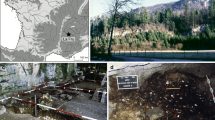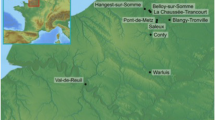Abstract
This paper presents new carbon, nitrogen and sulphur isotope data for European fallow deer (Dama dama dama) in Roman Britain and discusses results in light of evidence from classical texts, landscape archaeology, zooarchaeology and the limited available samples of metric data. The new isotope data presented here are from Fishbourne Roman Palace (Sussex), two sites on the Isle of Thanet (Kent) and a further two sites in London. In spite of small sample sizes the data make an important contribution to the very limited corpus of scientific research on the species and provide new resolution to the nature of fallow deer movement and management in Roman Britain.




Similar content being viewed by others
References
Ambrose SH (1993) Isotopic analysis of paleodiets: Methodological and interpretive considerations. In: Sandford MK (ed) Investigation of ancient human tissue: chemical analyses in anthropology. Gordon and Breach Science Publishers, Langhorne, pp 59–130
Ambrose SH (2000) Controlled diet and climate experiments on nitrogen isotope ratios of rats. In: Ambrose SH, Katzenberg MA (eds) Biogeochemical approaches to palaeodietary analysis. Kluwer Academic/Plenum Publishers, New York, pp 2432–2459
Ambrose SH, Norr L (1993) Experimental evidence for the relationship of the carbon isotope ratios of whole diet and dietary protein to those of bone collagen and carbonate. In: Lambert JB, Grupe G (eds) Prehistoric human bone: archaeology at the molecular level. Springer, New York, pp 1–37
Ballase M, Tresset A, Dobney K, Ambrose SH (2005) The use of isotope ratios to test for seaweed eating in sheep. J Zool Soc Lond 266:283–291
Barrett JH, Beukens RP, Nicholson RA (2001) Diet and ethnicity during the Viking colonization of Northern Scotland: Evidence from fish bones and stable carbon isotopes. Antiquity 75:145–154
Bendrey R (2003) The identification of fallow deer (Dama dama) remains from Roman Monkton, the Isle of Thanet, Kent. In: Riddler ID (ed) Materials of manufacture: the choice of materials in the working of bone and antler in northern and central Europe during the first millennium AD, vol S1193, British Archaeological Reports, International Series. Archaeopress, Oxford, pp 15–18
Böttcher ME, δger O, Höpner T, Brumsack H, Rullkötter J (1998) Sulfate reduction related to the early diagenetic degradation of organic matter and ‘black spot’ formation in tidal sandflats of the Genman Wadden Sea (southern North Sea): Stable isotope (13C, 34S, 18O) and other geochemical results. Org Geochem 29:1517–1530
Britton K, Müldner G, Bell M (2008) Stable isotope evidence for salt marsh grazing in the Bronze Age Severn Estuary, UK: implications for palaeodietary analysis at coastal sites. J Archaeol Sci 35:2111–2118
Brown TA, Nelson DE, Vogel JS, Southon JR (1988) Improved collagen extraction by modified Longin method. Radiocarbon 30:171–177
Bubenik G (1983) The endocrine regulation of the antler cycle. In: Brown R (ed) Antler development in cervidae. Texas A& I University, Kingsville, pp 73–107
Carden RF, Hayden TJ (2006) Epiphyseal fusion in the postcranial skeleton as an indicator of age at death of European fallow deer (Dama dama, Linnaeus, 1758). In: Ruscillo D (ed) Recent advances in ageing and sexing animal bones. Oxbow, Oxford, pp 227–236
Columella LJM (1955) (ed. & trans. by ES Forester, EH Heffner) On agriculture (Loeb Classical Library 361). Heinemann, London
Cowan C, Seeley F, Wardle A, Westman A, Wheeler L (2009) Roman Southwark settlement and economy: excavations in Southwark 1973–91. MOLA Monograph 42. Museum of London, London
Craig OE, Ross R, Andersen SH, Milner N, Bailey GN (2006) Focus: sulphur isotope variation in archaeological marine fauna from northern Europe. J Archaeol Sci 33:1642–1646
Cunliffe B (1971a) Excavations at Fishbourne 1961–1969, Vol. I, The Site (Reports of the Research Committee of the Society of the Antiquaries of London 26). The Society of Antiquaries, Leeds
Cunliffe B (1971b) Excavations at Fishbourne 1961–1969, Vol. I,The finds (Reports of the Research Committee of the Society of the Antiquaries of London 27). The Society of Antiquaries, Leeds
Cunliffe B (1998) Fishbourne Roman palace. Tempus, Stroud
Davies SJM, MacKinnon M (2009) Did the Romans bring fallow deer to Portugal? Environ Archaeol 14:15–26
DeNiro MJ (1985) Postmortem preservation and alteration of in vivo bone collagen isotope ratios in relation to paleodietary reconstruction. Nature 317:806–809
Drummond-Murray J, Wills O (1997) London Bridge Station Area 8, Station Approach, SE1 (Site Code: LBI95). Museum of London Archaeology Service Archive Report
Fuller BT, De Cupere B, Marinova E, Van Neer W, Waelkens M, Richards MP (2012) Isotopic Reconstruction of Human Diet and Animal Husbandry Practices During the Classical-Hellenistic, Imperial, and Byzantine Periods at Sagalassos, Turkey. Am J Phys Anthropol 149:157–171
Fuller BT, Fuller JL, Sage NE, Harris DA, O'Connell TC, Hedges REM (2005) Nitrogen balance and δ15N: Why you're not what you eat during nutritional stress. Rapid Commun Mass Spectrom 19:2497–2506
Grant A (1971) The animal bones. In: Cunliffe B (ed) Excavations at Fishbourne 1961–1969. Reports of the Research Committee of the Society of Antiquaries of London no. 27. Society of Antiquaries, London, pp 377–388
Hobson KA, Alisauskas RT, Clark RG (1993) Stable-nitrogen isotope enrichment in avian tissues due to fasting and nutritional stress: implications for isotopic analyses of diet. Condor 95:388–394
Ireland WH (1828) England’s Topographer, or a New and Complete History of the County of Kent, Geo. Virtue, London
Jones WHS (1963) Pliny Natural History, Volume VIII, Books XXVIII-XXXII. Harvard University Press, London
Katzenberg MA (2000) Stable isotope analysis: a tool for studying past diet, demography, and life history. In: Katzenberg MA, Saunders SR (eds) Biological anthropology of the human skeleton. Wiley-Liss Publishers, New York, pp 305–327
Katzenberg MA, Lovell NC (1999) Stable isotope variation in pathological bone. Int J Osteoarchaeol 9:316–324
Langbein J, Chapman N (2003) Fallow deer. Mammal Society, London
Leach BF, Quinn CJ, Lyon GL (1996) A stochastic approach to the reconstruction of prehistoric human diet in the pacific region from bone isotope signatures. Tuhinga 8:1–54
Lever C (1977) The naturalised animals of the British Isles. Granada Publishing, St. Albans
Lee-Thorp JA (2008) On isotopes and old bones. Archaeometry 50:925–950
Madgwick R, Mulville J, Stevens RE (2012) Diversity in foddering strategy and herd management in late Bronze Age Britain: an isotopic investigation of pigs and other fauna from two midden sites. Environ. Archaeol 17:126–140
Manley J, Rudkin D (2005) Facing the palace: excavations in front of the Roman palace at Fishbourne (Sussex, UK). Sussex Archaeol Collect 141:1995–1999
Massetti M (2002) Island of deer: natural history of the fallow deer of Rhodes and the vertebrates of the Dodecanese (Greece). City of Rhodes Environment Organisation, Rhodes
Masseti M, Cavallaro A, Pecchioli E, Vernesi C (2006) Artificial occurrence of the fallow deer Dama dama dama (L., 1758), on the island of Rhodes (Greece): Insight from mtDNA analysis. Hum Evol 21:167–176
Millais JG (1906) Mammals of Great Britain and Ireland. Longman, London
Morris J (nd) Assessment of the animal bone from Tothill Street, Minster, Kent (KT-TSM10). Unpublished Report, Museum of London Archaeology
Mulville J, Madgwick R, Stevens R, O’Connell T, Craig O, Powell A, Sharples N (2009) Isotopic analysis of faunal material from South Uist, Western Isles. Scotland J North Atl 2:51–59
Nehlich O, Fuller BT, Márquez-Grant N, Richards MP (2012) Investigation of diachronic dietary patterns in the islands of Ibiza and Formentera, Spain: Evidence from sulfur stable isotope ratio analysis. Am J Phys Anthropol 149:115–124
Privat KL, O’Connell TC, Hedges REM (2007) The distinction between freshwater- and terrestrial-based diets: methodological concerns and archaeological applications of sulphur stable isotope analysis. J Archaeol Sci 34:1197–1204
Rees CE, Jenkins WJ, Monster J (1978) The sulphure isotopic composition of ocean water sulphate. Geochim Cosmochim Acta 42:377–381
Richards MP, Fuller BT, Hedges REM (2001) Sulphur isotopic variation in ancient bone collagen from Europe: implications for human palaeodiet, residence mobility and modern pollutant studies. Earth Planetary Sci Lett 191:185–190
Richards MP, Fuller BT, Sponheimer M, Robinson T, Ayliffe L (2003) Sulphur isotopes in palaeodietary studies: a review and results from a controlled feeding experiment. Int J Osteoarchaeol 13:37–45
Schoeninger MJ, DeNiro MJ, Tauber H (1983) Stable nitrogen isotope ratios of bone collagen reflect marine and terrestrial components of prehistoric human diet. Science 220:1381–1383
Sealy J (2001) Body tissue chemistry and palaeodiet. In: Brothwell DR, Pollard AM (eds) Handbook of archaeological sciences. John Wiley and Sons Publishers, Chichester, pp 269–279
Sponheimer M, Robinson T, Ayliffe L, Roeder B, Hammer J, Passey B, West A, Cerling T, Dearing D, Ehleringer J (2003a) Nitrogen isotopes in mammalian herbivores: hair δ15N values from a controlled feeding study. Int J Osteoarchaeol 13:80–87
Sponheimer M, Robinson TF, Roeder BL, Passey BH, Ayliffe LK, Cerling TE, Dearing MD, Ehleringer JR (2003b) An experimental study of nitrogen flux in llamas: Is 14 N preferentially excreted? J Archaeol Sci 30:1649–1655
Stevens RE, Lightfoot E, Hamilton J, Cunliffe B, Hedges REM (2010) Stable isotope investigations of the Danebury hillfort pit burials. Oxf J Archaeol 29:407–428
Stevens R, Lister A, Hedges REM (2006) Predicting diet, trophic level and palaeoecology from bone stable isotope analysis: a comparative study of five red deer populations. Oecologia 149:12–21
Sykes NJ (2004) The introduction of fallow deer to Britain: a zooarchaeological perspective. Environ Archaeol 9:75–83
Sykes NJ (2007) Animal bones and animal parks. In: Liddiard R (ed) The Medieval deer park: new perspectives. Windgather Press, Macclesfield, pp 49–62
Sykes NJ (2010) Fallow deer. In: O’Connor TP, Sykes NJ (eds) Extinctions and invasions: a social history of British fauna. Windgather Press, Macclesfield, pp 51–58
Sykes NJ, Carden RF (2011) Were fallow deer spotted (OE *pohha/*pocca) in Anglo-Saxon England? Reviewing the evidence for Dama dama dama in early medieval Europe. Mediev Archaeol 59:139–161
Sykes NJ, White J, Hayes T, Palmer M (2006) Tracking animals using strontium isotopes in teeth: the role of fallow deer (Dama dama) in Roman Britain. Antiquity 80:1–12
Sykes NJ, Baker K, Carden RF, Higham TFG, Hoelzel AR, Stevens RE (2011a) New evidence for the establishment and management of the European fallow deer (Dama dama dama) in Roman Britain. J Archaeol Sci 38:156–165
Sykes NJ, Carden RF, Harris K (2011b) Changes in the size and shape of fallow deer—evidence for the movement and management of a species. Int. J. Osteoarchaeol. doi:10.1002/oa.1239
Vogel JC, Van der Merwe NJ (1977) Isotopic evidence for early maize cultivation in New York State. Am Antiq 42:238–242
Van Klinken GJ, Van der Plicht J, Hedges REM (1994) Bone 13C/12C ratios reXect (palaeo-) climatic variations. Geophys Res Lett 21:445–448
Webb SC, Hedges REM, Simpson SJ (1998) Diet quality influences the d13C and d15N of locusts and their biochemical components. J Exp Biol 201:2903–2911
Whitehead GK (1972) Deer of the world. Constable, London
Yalden D (1999) A history of British mammals. Poyser, London
Acknowledgements
This research was conducted as part of the Dama International Project, which is funded by the Arts and Humanities Research Council (standard grant no. AH/I026456/1). We are grateful to Rhiannon Stevens for her opinions on the data presented in this paper and to the two anonymous reviewers. Thanks also go to Lena Strid and Rebecca Nicholson for submitting and providing information on the samples from the East Kent Access Road. Data from Monkton, previously published by Sykes et al. (2011a) was acquired through a radiocarbon dating project funded by the Oxford Radiocarbon Accelerator Dating Service.
Author information
Authors and Affiliations
Corresponding authors
Rights and permissions
About this article
Cite this article
Madgwick, R., Sykes, N., Miller, H. et al. Fallow deer (Dama dama dama) management in Roman South-East Britain. Archaeol Anthropol Sci 5, 111–122 (2013). https://doi.org/10.1007/s12520-013-0120-0
Received:
Accepted:
Published:
Issue Date:
DOI: https://doi.org/10.1007/s12520-013-0120-0




